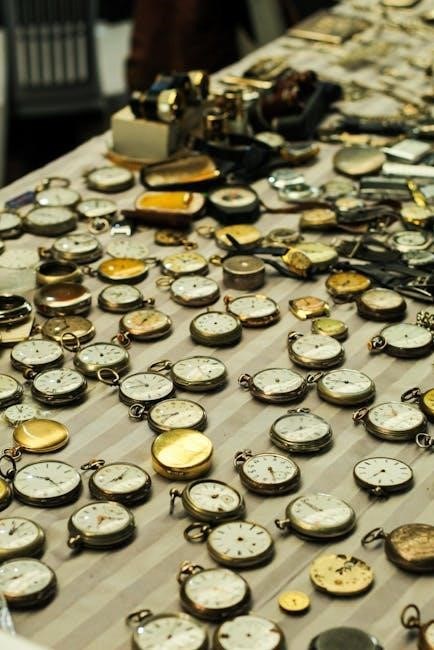Overview of 24-Hour Urine Collection
A 24-hour urine collection is a comprehensive test evaluating kidney function‚ hormone levels‚ and waste removal over a full day‚ providing accurate diagnosis and monitoring of medical conditions.
1.1 Purpose of the Test
The 24-hour urine collection test assesses kidney function by measuring waste products‚ hormones‚ and other substances in urine over a full day. It helps diagnose conditions like kidney disease‚ hormonal imbalances‚ or metabolic disorders‚ providing a comprehensive view of bodily functions compared to a single sample.
By evaluating the volume and composition of urine‚ the test aids in monitoring disease progression and treatment effectiveness‚ ensuring accurate and reliable results for medical evaluation and management.
1.2 Importance of Accurate Collection
Accurate 24-hour urine collection is crucial for obtaining reliable test results. Missing any urine samples or improper timing can lead to inaccurate measurements and the need for repeat testing‚ delaying diagnosis and treatment.
Strict adherence to instructions ensures precise evaluation of kidney function‚ hormone levels‚ and waste removal‚ making accurate collection essential for effective medical assessment and decision-making.
Preparation for the Test
Prepare by gathering materials like a collection container‚ labels‚ and instructions. Ensure the container is properly labeled with your name‚ date‚ and time for accuracy.
2.1 Materials Needed
A 24-hour urine collection requires a large‚ clean container with a tight-fitting lid‚ labels for your name and collection dates‚ ice packs or a cooler‚ and documentation for recording times. Additional materials may include a smaller collection cup for individual samples and gloves for handling. Ensure all supplies are provided by your healthcare provider to maintain sterility and accuracy.
2.2 Initial Instructions from Healthcare Provider
Your healthcare provider will give detailed instructions‚ including the exact start time‚ labeling the collection container with your name and date‚ and emphasizing the importance of collecting all urine during the 24-hour period. They may also discuss dietary restrictions‚ physical activity‚ and hydration guidelines to ensure accurate test results and proper specimen handling.
Starting the Collection
3.1 Emptying the Bladder to Begin
3.2 Timing and Documentation
Accurate timing is crucial for the 24-hour urine collection. Document the exact start time after the initial bladder emptying and discard the first sample. Record the time of each subsequent collection to ensure all samples are included in the 24-hour window. Complete the collection at the same time the next day‚ documenting the final sample time to maintain consistency and accuracy for reliable test results.
Collecting Urine Over 24 Hours
Collect all urine over 24 hours in the provided container‚ starting after the initial void. Save every sample‚ no matter how small‚ to ensure accurate test results.
4.1 Saving All Urine Samples
Saving all urine samples is crucial for accurate test results. Use the provided container to collect every void‚ ensuring no urine is missed. Proper storage in a cool place and correct labeling with name‚ date‚ and time are essential for reliable analysis and diagnosis.
4.2 Proper Use of the Collection Container
Use the collection container exclusively for urine samples. Avoid direct urination into the container; instead‚ use a secondary container to collect and transfer. Ensure the container remains clean‚ tightly sealed‚ and labeled with your name‚ date‚ and start time. Store it in the refrigerator or on ice to maintain sample integrity until submission.
Completing the Test
End the collection with the final urine sample‚ documenting the time. Ensure all urine is transferred to the container‚ seal it‚ and promptly return it to the lab.
5.1 Final Urine Sample
The final urine sample is collected exactly 24 hours after starting the test‚ including the first void of the second day. This ensures the full 24-hour period is captured for accurate results.
Document the end time and ensure the container is sealed properly. This step is crucial for completing the test and providing a reliable sample for analysis.
5.2 Returning the Sample to the Lab
After completing the 24-hour collection‚ ensure the container is sealed tightly and labeled with your name‚ date‚ and collection time. Store the sample in a cool place‚ such as a refrigerator‚ until transport to the lab. Return the sample promptly‚ ideally within two hours of finishing‚ to maintain accuracy and avoid sample degradation.
- Keep the container cool during transport.
- Deliver the sample to the lab without delay.
Handling and Storage
Store the 24-hour urine sample in a cool‚ dry place or refrigerator to prevent degradation. Use ice if refrigeration isn’t available. Avoid contamination and ensure timely delivery to the lab.
6.1 Keeping the Sample Cool
Keep the 24-hour urine collection container refrigerated or on ice to maintain sample integrity. Avoid direct sunlight and high temperatures‚ as this can degrade components. If refrigeration isn’t available‚ use ice packs or a cooler. Ensure the container remains sealed to prevent contamination and leakage during storage. Proper cooling helps preserve the sample for accurate laboratory analysis and reliable test results.
6.2 Avoiding Contamination
To prevent contamination‚ use a clean‚ sterile container provided by your healthcare provider. Avoid touching the inside of the container or lid with your hands. Do not expose the sample to direct sunlight or extreme temperatures; Keep the container tightly sealed when not in use. Avoid contact with metals or other substances that may alter test results. Proper handling ensures accurate analysis and reliable outcomes.

Common Mistakes to Avoid
- Forgetting to collect all urine samples during the 24-hour period.
- Incorrect timing or incomplete documentation of collection start and end times.
7.1 Forgetting to Collect All Samples
Forgetting to collect all urine samples during the 24-hour period is a common mistake. This can lead to incomplete results‚ making the test less accurate. Always ensure every voiding is collected‚ even small amounts‚ to avoid the need for repeat testing. Proper documentation and reminders can help prevent this oversight.
7.2 Incorrect Timing or Documentation
Incorrect timing or improper documentation can compromise test accuracy. Ensure the collection starts and ends at the same time‚ documenting each voiding. Missing or inaccurate timestamps may lead to unreliable results. Properly recording the start and end times is crucial for precise measurements and valid outcomes. Always double-check documentation to avoid errors.
Special Considerations
Special considerations include adhering to dietary restrictions and maintaining consistent physical activity levels. These factors ensure accurate test results and prevent external influences on urine composition during collection.
8.1 Dietary Restrictions
Dietary restrictions are essential to ensure accurate test results. Patients should avoid excessive salt‚ protein‚ or alcohol intake‚ as these can alter urine composition. A normal diet is recommended unless specified by the healthcare provider. Specific foods or supplements that could interfere with test results should be discussed beforehand to avoid misleading outcomes and ensure reliable diagnostic data; Consistency is key for precise measurement and analysis.
8.2 Physical Activity and Hydration
Physical activity and hydration levels can impact urine output and test accuracy. Patients should maintain normal hydration and avoid excessive fluid intake or dehydration. Strenuous exercise should be avoided during the collection period‚ as it may alter urine composition. Consistent hydration and activity levels help ensure accurate and reliable test results for proper diagnosis and monitoring of health conditions.
Role of the Test in Diagnosis
The 24-hour urine test evaluates kidney function‚ detects conditions like kidney disease or hormonal imbalances‚ and monitors treatment effectiveness for accurate diagnosis and management.
9.1 Monitoring Kidney Function
The 24-hour urine test measures kidney function by assessing waste removal‚ protein levels‚ and hormone excretion. It helps detect conditions like kidney disease or abnormal waste filtration‚ ensuring accurate monitoring and diagnosis of renal health issues.
9.2 Detecting Specific Medical Conditions
The 24-hour urine test identifies conditions like pheochromocytoma‚ kidney disease‚ and proteinuria by analyzing hormone and waste levels. It detects abnormal excretions‚ aiding in precise diagnosis and monitoring chronic illnesses‚ ensuring timely treatment and improved patient outcomes.

Follow-Up Instructions
After completing the test‚ schedule a consultation with your healthcare provider to discuss results and determine if repeat testing is necessary.
10.1 Discussing Results with Your Doctor
Schedule a follow-up appointment to review your test results. Your doctor will explain whether your urine levels are normal or abnormal‚ discussing any necessary next steps or additional testing for diagnosis or treatment.
10.2 Potential Need for Repeat Testing
If your test results are unclear‚ incomplete‚ or abnormal‚ your doctor may request a repeat collection. This ensures accuracy‚ especially if samples were missed‚ contaminated‚ or timing was incorrect. Repeat testing helps confirm diagnoses or monitor conditions effectively.

Patient FAQs
What if I forget a sample? Contact your doctor immediately. Can I continue normal activities? Yes‚ but ensure all urine is collected for accurate results.
11.1 What If I Forget to Collect a Sample?
Forgetting a sample can lead to inaccurate results. If this happens‚ contact your healthcare provider immediately for guidance. They may advise repeating the collection or adjusting the test schedule to ensure reliable outcomes.
11.2 Can I Continue Normal Activities During Collection?
Yes‚ you can continue normal activities‚ but ensure all urine is collected. Maintain usual hydration and physical activity levels unless specified otherwise. Accurate collection is crucial for reliable results‚ so follow instructions carefully to avoid needing to repeat the test.

Key Takeaways
Adhering to instructions ensures accurate results. Proper collection and storage are essential for reliable diagnostic outcomes. Your cooperation is vital for a successful 24-hour urine test.
12.1 Importance of Adhering to Instructions
Following instructions precisely ensures accurate test results. Missing samples or improper storage can lead to repeat testing. Adhering to guidelines helps diagnose conditions correctly and monitor treatment effectively‚ avoiding potential errors.
12.2 Ensuring Accuracy for Reliable Results
Accurate collection is crucial for reliable test outcomes. Missing samples or improper storage can lead to incorrect results‚ requiring repeat testing. Precise measurement of urine volume and adherence to instructions ensure valid data‚ enabling accurate diagnosis and effective monitoring of medical conditions like kidney function or hormone levels.

Additional Resources
Downloadable instructional PDFs are available for detailed guidance. Contact your healthcare provider for further clarifications or additional resources.
13.1 Downloadable Instructional PDFs
Downloadable instructional PDFs provide step-by-step guides for 24-hour urine collection‚ including preparation‚ sampling‚ and storage. These resources often include checklists‚ diagrams‚ and summaries to ensure accurate test results. Many healthcare providers offer these PDFs on their websites‚ allowing patients to access detailed instructions at home. They are designed to be user-friendly and accessible for optimal compliance with collection protocols.
13.2 Contacting Your Healthcare Provider for Clarifications
If you have questions or need further guidance‚ contacting your healthcare provider ensures clarity and accuracy in the collection process. They can address specific concerns‚ confirm instructions‚ and provide additional resources. This step is crucial for avoiding errors and ensuring reliable test results‚ especially if you encounter unusual situations during the 24-hour period.